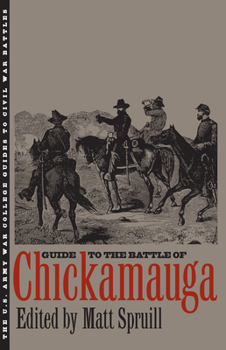Guide to the Battle of Chickamauga
(Part of the U.S. Army War College Guides to Civil War Battles Series)
Select Format
Select Condition 
Book Overview
Not far from Chattanooga in northern Georgia, the Confederacy won one of its most decisive battles. This guide uses first-hand accounts to illustrate how this skirmish, only two days long, turned into... This description may be from another edition of this product.
Format:Paperback
Language:English
ISBN:0700605967
ISBN13:9780700605965
Release Date:May 1993
Publisher:University Press of Kansas
Length:328 Pages
Weight:0.79 lbs.
Dimensions:0.9" x 5.5" x 8.5"
Customer Reviews
3 ratings
Helpful guide to exploring the Chickamauga battlefield
Published by Thriftbooks.com User , 16 years ago
The Army War College has developed a nice series of books on key battles of the Civil War. One highlight is the provision of suggested sites to visit on the battlefield, to get a better sense of what was happening "on the ground" back in 1863. For example, Stop 20 is the point on the battlefield site where Confederate General James Longstreet attacked the Union defensive positions just as a gap developed in the northern lines. There is a description of how to orient oneself at this point. Then, a brief description of the key events here. Next, battlefield reports, written after the event, by officers on both sides about what happened as that gap developed. One can read Longstreet's version--as well as that of Union Brigadier General Thomas Wood, whose movement, under less than precise orders from commanding General William Rosecrans, produced the catastrophic situation for the defensive posture established by the Union forces. There were many Union commanders who had their careers tarnished at Chickamauga, including Rosecrans himself. One who burnished his credentials, of course, was the man who came to be known as "The Rock of Chickamauga," Virginian Major General George Thomas, who commanded the left end of the Union line. While other divisions and corps fled the field in disarray, Thomas cobbled together a defensive position on Snodgrass Hill and saved the day. Pages 199 through 230 describe the events, from commanders' perspectives, taking place at Snodgrass Hill, including General Granger's "in the nick of time" reserve arriving to provide additional forces for Thomas' stand. Other features: the order of battle that provides a listing of the units and commanders at brigade command level and above; an essay on medical practices and the care of the wounded. For those wanting to see the battlefield and get a sense of what happened, this is a useful volume. The battle's conduct, through the words of commanders reporting their perceptions of what happened (which can be self-serving and sometimes even inaccurate), is interesting reading to me. All in all, a useful work. . . .
Badly needed for this park
Published by Thriftbooks.com User , 16 years ago
The Chickamauga battlefield guide published in 1997 and the first not edited by Jay Luvaas. Matt Spruill maintains the series standards and format started with the Gettysburg guide. The book covers the first major victory of the Confederate Army of Tennessee in the American Civil War. This victory, coming after the defeat at Gettysburg and Vicksburg's surrender brightened Confederate hopes in the Fall of 1863. New features include a 30-page essay on Civil War medical and a section of aftermath. The Chickamauga Park covers two days of fighting and many positions overlap. This leads to some understandable confusion for visitors while viewing monuments and trying to understand the battle. For anything beyond the park driving tour, this book is essential. The series format is directions to a point on the field, orientation, a general lesson on what happened in your view, followed by first person accounts of the action. These guides are designed using the general staff training concept of a Staff Ride. This is when a class is taken to a historic location, discuss what happened and see how the terrain influences the event. Staff Rides are designed to be intensive "on the ground" training coupled with physical observation in the hopes students will gain experience for later use. I am not saying this to frighten you away from this guide but to tell you this is not a walk about and look at the monuments type of guide. This guide will have several pages devoted to the action at this point. It may contain a critique of the local commander's actions with possible alternates. My experience is that reading the book prior to my visit works best. This allows me more time observing the field and less time reading the book. Of the tour options, a professional guide is usually the best but most expensive choice. The park driving tour is the best choice for a quick trip through the field to get the kids passport stamp. This book is the best choice for a serious student of the battle looking for a detailed explanation.
Indispensable...
Published by Thriftbooks.com User , 18 years ago
I just completed a hike of the Chickamauga NBP, using Colonel Spruill's guide book. The book transformed a pleasant day outdoors into an informative learning experience. The hiking directions are precise. The selected narrations by the participants enhance understanding of the action on the field, and Colonel Spruill's additional notations explain the narrations in a larger context. If you're serious about getting the most out of a visit to Chickamauga, then this book is a required item in your rucksack.






